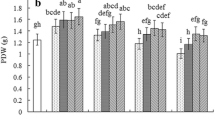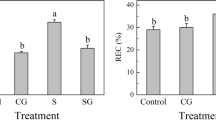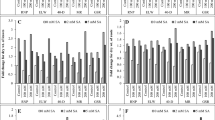Abstract
Exogenous salicylic acid (SA) can be used for chemical hardening to alleviate oxidative stress in plants exposed to salinity. The treatment of 5-week-old Arabidopsis thaliana plants with increasing doses of SA alters the ascorbate (ASC) and glutathione (GSH) pools, and modulates their redox status and the activity of several antioxidant enzymes, such as ascorbate peroxidase (APX) and glutathione reductase (GR). To investigate the role of GR in the maintenance of cytoplasmic redox homeostasis after hardening by SA, wild type (WT) and gr1 mutant plants, expressing the cytoplasmic redox-sensitive green fluorescent protein (c-roGFP1), were pre-treated with 10−7 and 10−5 M SA for 2 weeks and subsequently exposed to 100 mM NaCl. The redox status of the salt-stressed WT plants became more oxidized, which was prevented by pretreatment with 10−5 M SA. The gr1 mutants showed more positive redox potential than WT plants, which could be reversed by treatment with 10−5 M SA. In mutants, the increased GSH levels may have compensated for the deleterious effect of GR deficiency and stabilized the redox potential in plants exposed to salinity. The ASC regeneration in WT plants shifted from the GSH-dependent dehydroascorbate reductase (DHAR) reaction to the NAD(P)H-dependent monodehydroascorbate reductase (MDHAR) activity during chemical hardening, which contributed to the preservation of the GSH pool in plants under salt stress. Our results suggest that the maintenance of GSH levels and redox homeostasis by SA-mediated hardening play a major role in priming and defending against salt stress.




Similar content being viewed by others
Abbreviations
- APX:
-
Ascorbate peroxidase
- ASC:
-
Ascorbate
- c-roGFP1:
-
Cytoplasmic redox-sensitive green fluorescent protein
- DHAR:
-
Dehydroascorbate reductase
- E GSH :
-
Glutathione reduction potential
- E roGFP :
-
Reduction potential of roGFP1
- GR:
-
Glutathione reductase
- gr1 :
-
Glutathione reductase1 mutant
- GSH:
-
Reduced glutathione
- GSSG:
-
Glutathione disulphide, oxidized glutathione
- MDHAR:
-
Monodehydroascorbate reductase
- NPR1 :
-
Non-expressor of pathogenesis-related genes1
- ROS:
-
Reactive oxygen species
- SA:
-
Salicylic acid
- TRX:
-
Thioredoxin
- WT:
-
Wild type
References
Aller I, Rouhier N, Meyer AJ (2013) Development of roGFP2-derived redox probes for measurement of the glutathione redox potential in the cytosol of severely glutathione-deficient rml1 seedlings. Front Plant Sci 4:506
Antoniou C, Savvides A, Christou A, Fotopoulos V (2016) Unravelling chemical priming machinery in plants: the role of reactive oxygen-nitrogen-sulfur species in abiotic stress tolerance enhancement. Curr Opin Plant Biol 33:101–107
Baxter A, Mittler R, Suzuki N (2014) ROS as key players in plant stress signalling. J Exp Bot 65:1229–1240
Beckers GJ, Conrath U (2007) Priming for stress resistance: from the lab to the field. Curr Opin Plant Biol 10:425–431
Begara-Morales JC, Sanchez-Calvo B, Chaki M, Mata-Perez C, Valderrama R, Padilla MN, Lopez-Jaramillo J, Luque F, Corpas FJ, Barroso JB (2015) Differential molecular response of monodehydroascorbate reductase and glutathione reductase by nitration and S-nitrosylation. J Exp Bot 66:5983–5996
Boguszewska D, Zagdańska B (2012) ROS as signaling molecules and enzymes of plant response to unfavorable environmental conditions. In: Lushchak V (ed) Oxidative stress—molecular mechanisms and biological effects, InTech, Rijeka, pp 341–362, http://www.intechopen.com, ISBN: 978-953-51-0554-1
Chen Z, Gallie DR (2004) The ascorbic acid redox state controls guard cell signaling and stomatal movement. Plant Cell 16:1143–1162
Couturier J, Chibani K, Jacquot JP, Rouhier N (2013) Cysteine-based redox regulation and signaling in plants. Front Plant Sci 4:105
Csiszár J, Horváth E, Váry Z, Gallé Á, Bela K, Brunner Sz, Tari I (2014) Glutathione transferase supergene family in tomato: salt stress-regulated expression of representative genes from distinct GST classes in plants primed with salicylic acid. Plant Physiol Biochem 78:15–26
D’Autréaux B, Toledano MB (2007) ROS as signalling molecules: mechanisms that generate specificity in ROS homeostasis. Nat Rev Mol Cell Biol 8:813–824
Dat J, Vandenabeele S, Vranova E, Van Montagu M, Inze D, Van Breusegem F (2000) Dual action of the active oxygen species during plant stress responses. Cell Mol Life Sci 57:779–795
Delorme-Hinoux V, Bangash SAK, Meyer AJ, Reichheld JP (2016) Nuclear thiol redox systems in plants. Plant Sci 243:84–95
Diaz-Vivancos P, de Simone A, Kiddle G, Foyer CH (2015) Glutathione—linking cell proliferation to oxidative stress. Free Radic Biol Med 89:1154–1164
Ding SH, Lu QT, Zhang Y, Yang ZP, Wen XG, Zhang LX, Lu CM (2009) Enhanced sensitivity to oxidative stress in transgenic tobacco plants with decreased glutathione reductase activity leads to a decrease in ascorbate pool and ascorbate redox state. Plant Mol Biol 69:577–592
Dixon DP, Davis BG, Edwards R (2002) Functional divergence in the glutathione transferase superfamily in plants—identification of two classes with putative functions in redox homeostasis in Arabidopsis thaliana. J Biol Chem 277:30859–30869
Foyer CH, Noctor G (2005) Redox homeostasis and antioxidant signaling: a metabolic interface between stress perception and physiological responses. Plant Cell 17:1866–1875
Foyer CH, Noctor G (2011) Ascorbate and glutathione: the heart of the redox hub. Plant Physiol 155:2–18
Foyer CH, Noctor G (2016) Stress-triggered redox signalling: what’s in pROSpect? Plant Cell Environ 39:951–964
Gémes K, Poór P, Horváth E, Kolbert Zs, Szopkó D, Szepesi Á, Tari I (2011) Cross-talk between salicylic acid and NaCl-generated reactive oxygen species and nitric oxide in tomato during acclimation to high salinity. Physiol Plant 142:179–192
Gill SS, Anjum NA, Hasanuzzaman M, Gill R, Trivedi DK, Ahmad I, Pereira E, Tuteja N (2013) Glutathione and glutathione reductase: a boon in disguise for plant abiotic stress defense operations. Plant Physiol Biochem 70:204–212
Han Y, Chaouch S, Mhamdi A, Queval G, Zechmann B, Noctor GD (2013) Functional analysis of Arabidopsis mutants points to novel roles for glutathione in coupling H2O2 to activation of salicylic acid accumulation and signaling. Antioxid Redox Signal 18:2106–2121
Hanson GT, Aggeler R, Oglesbee D, Cannon M, Capaldi RA, Tsien RY, Remington SJ (2004) Investigating mitochondrial redox potential with redox-sensitive green fluorescent protein indicators. J Biol Chem 279:13044–13053
Hayat Q, Hayat S, Irfan M, Ahmad A (2010) Effect of exogenous salicylic acid under changing environment: a review. Environ Exp Bot 68:14–25
Hicks LM, Cahoon RE, Bonner ER, Rivard RS, Sheffield J, Jez JM (2007) Thiol-based regulation of redox-active glutamate-cysteine ligase from Arabidopsis thaliana. Plant Cell 19:2653–2661
Horváth E, Szalai G, Janda T (2007) Induction of abiotic stress tolerance by salicylic acid signaling. J Plant Growth Regul 26(3):290–300
Horváth E, Brunner Sz, Bela K, Papdi Cs, Szabados L, Tari I, Csiszár J (2015) Exogenous salicylic acid-triggered changes in the glutathione transferases and peroxidases are key factors in the successful salt stress acclimation of Arabidopsis thaliana. Funct Plant Biol 42:1129–1140
Hossain MA, Nakano Y, Asada K (1984) Monodehydroascorbate reductase in spinach chloroplasts and its participation in regeneration of ascorbate for scavenging hydrogen peroxide. Plant Cell Physiol 25:385–395
Janda T, Szalai G, Tari I, Páldi E (1999) Hydroponic treatment with salicylic acid decreases the effects of chilling injury in maize (Zea mays L.) plants. Planta 208:175–180
Jiang K, Schwarzer C, Lally E, Zhang S, Ruzin S, Machen T, Remington SJ, Feldman L (2006) Expression and characterization of a redox-sensing green fluorescent protein (reduction-oxidation-sensitive green fluorescent protein) in Arabidopsis. Plant Physiol 141:397–403
Jiang K, Moe-Lange J, Hennet L, Feldman LJ (2016) Salt stress affects the redox status of Arabidopsis root meristems. Front Plant Sci 7:81
Jimenez A, Hernandez JA, del Rio LA, Sevilla F (1997) Evidence for the presence of the ascorbate-glutathione cycle in mitochondria and peroxisomes of pea leaves. Plant Physiol 114:275–284
Ma LH, Takanishi CL, Wood MJ (2007) Molecular mechanism of oxidative stress perception by the Orp1 protein. J Biol Chem 282:31429–31436
Marty L, Siala W, Schwarzländer M, Fricker MD, Wirtz M, Sweetlove LJ, Meyer Y, Meyer AJ, Reichheld JP, Hell R (2009) The NADPH-dependent thioredoxin system constitutes a functional backup for cytosolic glutathione reductase in Arabidopsis. Proc Natl Acad Sci USA 106:9109–9114
Meyer AJ, Dick TP (2010) Fluorescent protein-based redox probes. Antioxid Redox Signal 13:621–650
Meyer AJ, Brach T, Marty L, Kreye S, Rouhier N, Jacquot JP, Hell R (2007) Redox-sensitive GFP in Arabidopsis thaliana is a quantitative biosensor for the redox potential of the cellular glutathione redox buffer. Plant J 52:973–986
Mhamdi A, Hager J, Chaouch S, Queval G, Han Y, Taconnat L, Saindrenan P, Gouia H, Issakidis-Bourguet E, Renou JP, Noctor G (2010) Arabidopsis GLUTATHIONE REDUCTASE1 plays a crucial role in leaf responses to intracellular hydrogen peroxide and in ensuring appropriate gene expression through both salicylic acid and jasmonic acid signaling pathways. Plant Physiol 153:1144–1160
Mou Z, Fan W, Dong X (2003) Inducers of plant systemic acquired resistance regulate NPR1 function through redox changes. Cell 113:935–944
Munné-Bosch S, Queval G, Foyer CH (2013) The impact of global change factors on redox signaling underpinning stress tolerance. Plant Physiol 161:5–19
Nakano Y, Asada K (1987) Purification of ascorbate peroxidase in spinach chloroplasts: its inactivation in ascorbate-depleted medium and reactivation by monodehydroascorbate radical. Plant Cell Physiol 28:131–140
Noctor G (2006) Metabolic signalling in defence and stress: the ecentral roles pof soluble redox couples. Plant Cell Environ 29:409–425
Noctor G, Foyer CH (1998) Ascorbate and glutathione: kee** active oxygen under control. Annu Rev Plant Physiol Plant Mol Biol 49:249–279
Noctor G, Queval G, Mhamdi A, Chaouch S, Foyer CH (2011) Glutathione. Arabidopsis Book, 9:1–32
Noctor G, Mhamdi A, Chaouch S, Han Y, Neukermans J, Marquez-Garcia B, Queval G, Foyer CH (2012) Glutathione in plants: an integrated overview. Plant Cell Environ 35:454–484
Popova LP, Maslenkova LT, Yordanova RY, Ivanova AP, Krantev AP, Szalai G, Janda T (2009) Exogenous treatment with salicylic acid attenuates cadmium toxicity in pea seedlings. Plant Physiol Biochem 47:224–231
Potters G, Horemans N, Jansen MAK (2010) The cellular redox state in plant stress biology – A charging concept. Plant Physiol Bioch 48(5):292–300. https://doi.org/10.1016/j.plaphy.2009.12.007
Rao AC, Reddy AR (2008) Glutathione reductase: a putative redox regulatory system in plant cells. In: Khan NA, Singh S, Umar S (eds) Sulfur assimilation and abiotic stress in plants. Springer, Heidelberg, pp 111–147
Rosenwasser S, Rot I, Meyer AJ, Feldman L, Jiang K, Friedman H (2010) A fluorometer-based method for monitoring oxidation of redox-sensitive GFP (roGFP) during development and extended dark stress. Physiol Plant 138:493–502
Savvides A, Ali S, Tester M, Fotopoulos V (2016) Chemical priming of plants against multiple abiotic stresses: mission possible? Trends Plant Sci 21:329–340
Schnaubelt D, Queval G, Dong Y, Diaz-Vivancos P, Makgopa ME, Howell G, De Simone A, Bai J, Hannah MA, Foyer CH (2015) Low glutathione regulates gene expression and the redox potentials of the nucleus and cytosol in Arabidopsis thaliana. Plant Cell Environ 38:266–279
Schwarzländer M, Fricker MD, Müller C, Marty L, Brach T, Novak J, Sweetlove LJ, Hell R, Meyer AJ (2008) Confocal imaging of glutathione redox potential in living plant cells. J Microsc 231:299–316
Shalata A, Neumann PM (2001) Exogenous ascorbic acid (vitamin C) increases resistance to salt stress and increases resistance to salt stress and reduces lipid peroxidation. J Exp Bot 52:2207–2211
Shirasu K, Nakajima H, Rajashekar K, Dixon RA, Lamb C (1997) Salicylic acid potentiates an agonist-dependent gain control that amplifies pathogen signal in the activation of defense mechanisms. Plant Cell 9:261–270
Shu DF, Wang LY, Duan M, Deng YS, Meng QW (2011) Antisense-mediated depletion of tomato chloroplast glutathione reductase enhances susceptibility to chilling stress. Plant Physiol Biochem 49:1228–1237
Spadaro D, Yun BW, Spoel SH, Chu C, Wang YQ, Loake GJ (2010) The redox switch: dynamic regulation of protein function by cysteine modifications. Physiol Plant 138:360–371
Szepesi Á, Csiszár J, Gallé Á, Gémes K, Poór P, Tari I (2008) Effects of long-term salicylic acid pre-treatment on tomato (Lycopersicon esculentum Mill. L.) salt stress tolerance: changes in glutathione S-transferase activities and anthocyanin contents. Acta Agron Hung 56:129–138
Szepesi Á, Csiszár J, Gémes K, Horváth E, Horváth F, Simon ML, Tari I (2009) Salicylic acid improves acclimation to salt stress by stimulating abscisic aldehyde oxidase activity and abscisic acid accumulation, and increases Na+ content in leaves without toxicity symptoms in Solanum lycopersicum L. J Plant Physiol 166:914–925
Tada Y, Spoel SH, Pajerowska-Mukhtar K, Mou ZL, Song JQ, Wang C, Zuo JR, Dong XN (2008) Plant immunity requires conformational charges of NPR1 via S-nitrosylation and thioredoxins. Science 321:952–956
Tanou G, Filippou P, Belghazi M, Job D, Diamantidis G, Fotopoulos V, Molassiotis A (2012) Oxidative and nitrosative-based signaling and associatedpost-translational modifications orchestrate the acclimation of citrus plants to salinity stress. Plant J 72:585–599
Tari I, Csiszár J, Szalai G, Horváth F, Pécsváradi A, Kiss G, Szepesi Á, Szabó M, Erdei L (2002) Acclimation of tomato plants to salinity stress after a salicylic acid pre-treatment. Acta Biol Szeged 46:55–56
Tari I, Csiszár J, Horváth E, Poór P, Takács Z, Szepesi Á (2015) Alleviation of the adverse effect of salt stress in tomato by salicylic acid shows time- and organ-specific antioxidant response. Acta Biol Crac Bot 57:1–10
Tsai YC, Hong CY, Liu LF, Kao CH (2005) Expression of ascorbate peroxidase and glutathione reductase in roots of rice seedlings in response to NaCl and H2O2. J Plant Physiol 162:291–299
Tzafrir I, Pena-Muralla R, Dickerman A, Berg M, Rogers R, Hutchens S, Sweeney TC, McElver J, Aux G, Patton D, Meinke D (2004) Identification of genes required for embryo development in Arabidopsis. Plant Physiol 135:1206–1220
Waszczak C, Akter S, Eeckhout D, Persiau G, Wahni K, Bodra N, Van Molle I, De Smet B, Vertommen D, Gevaert K, De Jaeger G, Van Montagu M, Messens J, Van Breusegem F (2014) Sulfenome mining in Arabidopsis thaliana. Proc Natl Acad Sci USA 111:11545–11550
Acknowledgements
We would like to thank Dr. M. Schwarzländer for the c-roGFP1-harbouring Arabidopsis seeds. This study was supported by the Hungarian National Research, Development and Innovation Office [Grant Numbers: OTKA K 105956 and NKFI-1 PD 121027] and by the Hungary-Serbia IPA Cross-border Co-operation Programme [HUSRB/1203/221/173].
Author information
Authors and Affiliations
Corresponding author
Electronic supplementary material
Below is the link to the electronic supplementary material.
Rights and permissions
About this article
Cite this article
Csiszár, J., Brunner, S., Horváth, E. et al. Exogenously applied salicylic acid maintains redox homeostasis in salt-stressed Arabidopsis gr1 mutants expressing cytosolic roGFP1. Plant Growth Regul 86, 181–194 (2018). https://doi.org/10.1007/s10725-018-0420-6
Received:
Accepted:
Published:
Issue Date:
DOI: https://doi.org/10.1007/s10725-018-0420-6




